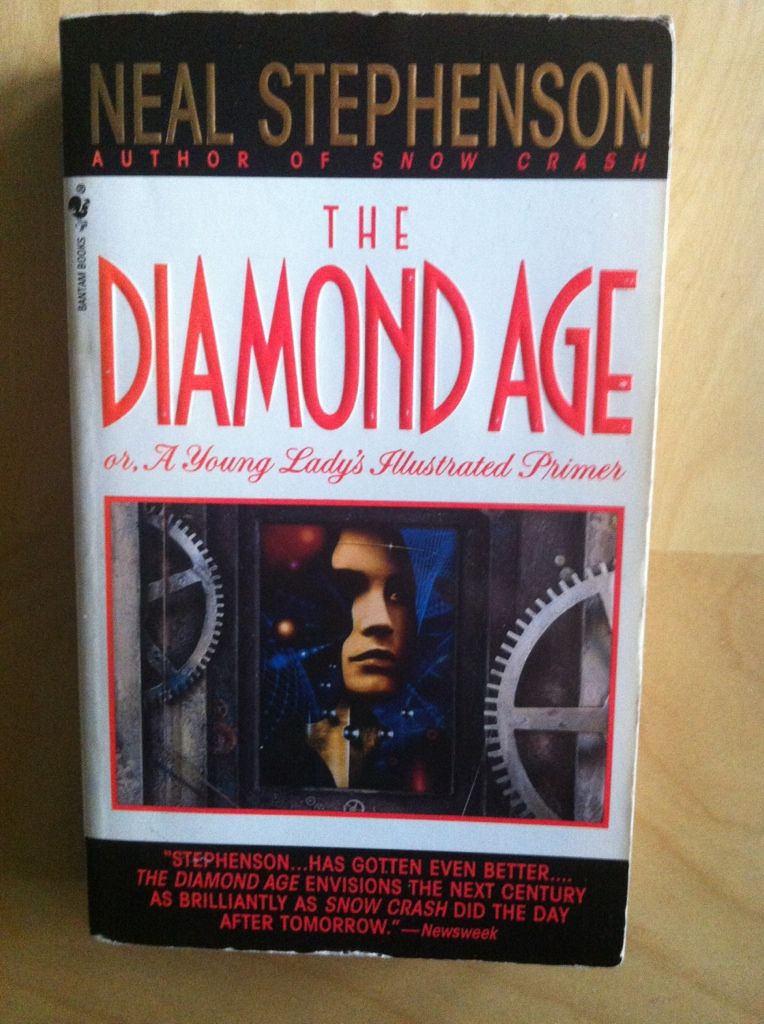Or why you should read the novels Snow Crash and The Diamond Age: Or a Young Lady's Illustrated Primer by Neal Stephenson
Neal Stephenson is kind of a big deal to me. As might be apparent if you've been following my nonsense at all, I kind of love novels that look at some aspect of life or technology, and just pick it apart in an entertaining way. For me, Neal Stephenson is the master of this kind of discursive, insightful analytical approach to fiction. He has this... perfect way of taking something straightforward, canting it to reveal an unseen facet, and then bombarding it with absolutely unexpected spectra of imagination to uncover something ideal about the concept. It's like making things more real through fiction. I am always entertained by his novels and, in the process, enlightened, somehow. It's pretty great.
Now, I enjoy all of Stephenson's novels. However, like most creative forces, there is a certain arc to his output. His most recent novels are heavily refined works of a master writer, and reflect his experience, while his very earliest novels are fossils of someone still developing their voice. But in between the two are these novels that are kind of magical; the Cambrian Explosion of Stephenson fiction, where the raw experimentation met craft and created these sublime moments of prose. For me, these novels are Snow Crash and The Diamond Age, and they are among my very favourites.
Snow Crash: Is this perfect realisation of a cyberpunk retro-future, that centres around the intersection of Metaverse VR Hackers and the linguistic magic of the ancient Sumerians set in the fragmented, Burbclaved dystopian remnants of the United States of America. It focuses on Hacker, swordsmen, and sometime Costra Nostra Pizza Deliverator, Hiro Protagonist and teenage Skateboard Kourier Y.T. as they form a partnership to gather and archive intelligence for the Central Intelligence Corporation (a merged byproduct of the CIA and Library of Congress) which pits them against an ancient curse, a fanatical religion, and an Aleutian nuclear power with Poor Impulse Control. It is one of the craziest, rawest, and most insightful things I have ever read.
But more than that, Snow Crash is this perfect realisation of the early 90's. Sure, it's a time I barely experienced (given that I was a child at the time), but Snow Crash absolutely encapsulates my sense of the decade. This is one EXTREME novel, with car-harpooning skateboarders and sword fights in virtual reality and The Deliverator and mini-guns and nuclear powered cyborg attack dogs. America has been broken into franchised nation states run by corporations with all of the subtlety and style of Dominos Pizza and 7-11. There is religious fundamentalism influencing power brokers, and poorly understood sexually transmitted diseases, and drugs that are barely invented, and stickers with "Smooth Move Ex-lax" written on them. Even as our present diverges further, and further from the future portrayed in Snow Crash, the novel lives on as this snapshot of the 90s zeitgeist. This is a novel that absolutely everyone has to read.
The Diamond Age: Or A Young Lady's Illustrated Primer: is, appropriately, a much more refined and elaborate kind of novel. The novel portrays a very distinct, very original concept of a future where nano-technology using societies are organized intro self-selecting tribes based upon ancient cultures. The Diamond Age takes place largely within the various enclaves of the Chinese Coastal Republic and begins when Lord Alexander Chung-Sik Finkle-McGraw, a high ranking noble of the Victorian tribe worrying about the effects of orthodox education, commissions Bespoke nano-tech engineer John Percival Hackworth to create a wondrous new book/computer for his granddaughter Elizabeth. Hackworth, guided by paternal hopes for his own daughter Fiona, steals a copy of the design for The Young Lady's Illustrated Primer and enlists Dr. X, an illicit technology broker of the Celestial Kingdom, to build a duplicate. Unfortunately, Hackworth is waylaid by street ruffians and the magic book falls into the hands of Nell, a poor tribeless Thete sired by the cyberpunk thug Bud and born of the unmaternal Tequila. Complications ensue, and what follows is a tale of social class, education, family, the war for the future of China, and the development of a new and awesome technology.
The Diamond Age is kind of perfect. Where Snow Crash is this raw, amazing time capsule, The Diamond Age is prisitine and timeless. It is immaculately engineered prose and ornately crafted ideas carved into an emotionally arresting narrative. Less fist pumping jawesomeness, and more dream architecture. It deals with the gonzo fallout of cultural collision and identity, social class and philosophy, and the every-more-relevant concepts of self-selecting communities and friction between ideologies. But more than that, The Diamond Age meditates on the universal themes of education, the magic of imagination, and the power of these to shape lives in just a really beautiful way. In many ways, I think The Diamond Age is the Ur-Stephenson novel: while Snow Crash does set up many of his favourite themes, The Diamond Age realizes them in this mature way that is utterly recognizable in his later works. It feels very much like the foundation of our contemporary Neal Stephenson.
I would recommend these novels to everyone. Snow Crash is just such an absolute kick-to-the-nuts of prose that is simultaneously this incredible cultural artifact of the 90's. It is, most deservedly so, one of those 100 novels everyone should read and in my view absolute canon for any Science Fiction fan. The Diamond Age, should also be a book everyone reads. Its themes are timeless, and if anything, more relevant today than when the novel was originally written. But beyond that, The Diamond Age is just an absolutely fascinating construct... like crystallized imagination. It is a bit challenging but well worth the effort.


No comments:
Post a Comment